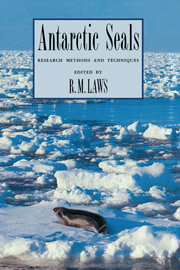Book contents
- Frontmatter
- Contents
- List of contributors
- Preface
- Introduction
- 1 Identification of species
- 2 Estimation of population sizes
- 3 Immobilization and capture
- 4 Marking techniques
- 5 Telemetry and electronic technology
- 6 Behaviour
- 7 Killing methods
- 8 Morphometrics, specimen collection and preservation
- 9 Genetic-based studies for stock separation
- 10 Collection of material for the determination of organochlorine and heavy metal levels
- 11 Age determination
- 12 Reproduction
- 13 Diet
- 14 Bioenergetics
- 15 Development of technology and research needs
- 16 Appendices
- Index
4 - Marking techniques
Published online by Cambridge University Press: 05 February 2010
- Frontmatter
- Contents
- List of contributors
- Preface
- Introduction
- 1 Identification of species
- 2 Estimation of population sizes
- 3 Immobilization and capture
- 4 Marking techniques
- 5 Telemetry and electronic technology
- 6 Behaviour
- 7 Killing methods
- 8 Morphometrics, specimen collection and preservation
- 9 Genetic-based studies for stock separation
- 10 Collection of material for the determination of organochlorine and heavy metal levels
- 11 Age determination
- 12 Reproduction
- 13 Diet
- 14 Bioenergetics
- 15 Development of technology and research needs
- 16 Appendices
- Index
Summary
Introduction
In studies of population ecology or behaviour it is essential to be able to mark individuals in such a way that they can be positively identified when they are re-observed. For certain purposes, however, it is sufficient to identify year classes or a specific group of seals. Even then, if it can be done, individual marking should be attempted because it has the potential of giving so much more information.
The techniques adopted will depend upon the objectives of the research. Long-term marking by brands, tags or intra-vitam staining is necessary for validating age criteria by means of known-age animals; for stock identification; for studies of population dynamics and longevity; for dispersal and migration studies; and for assessing breeding success (e.g. the frequency of pupping). Also in behavioural studies, temporary conspicuous marks can often be used individually or in combination with a routine tagging programme.
The more permanent marking methods usually require a measure of restraint of the animal. This usually presents no problem where pups are concerned, and even adults of some species can be tagged without first restraining them. Usually, however, adults must be immobilized, particularly if reliable weights and measurements are to be taken, if a tooth is to be extracted for age determination, or if the marking procedure is complex. Methods of immobilization and capture are described in chapter 3. The bagging technique devised by Stirling (1966) is adequate for several of the ice-breeding seals with or without partial drugging to slow them down.
- Type
- Chapter
- Information
- Antarctic SealsResearch Methods and Techniques, pp. 89 - 118Publisher: Cambridge University PressPrint publication year: 1993
- 15
- Cited by



